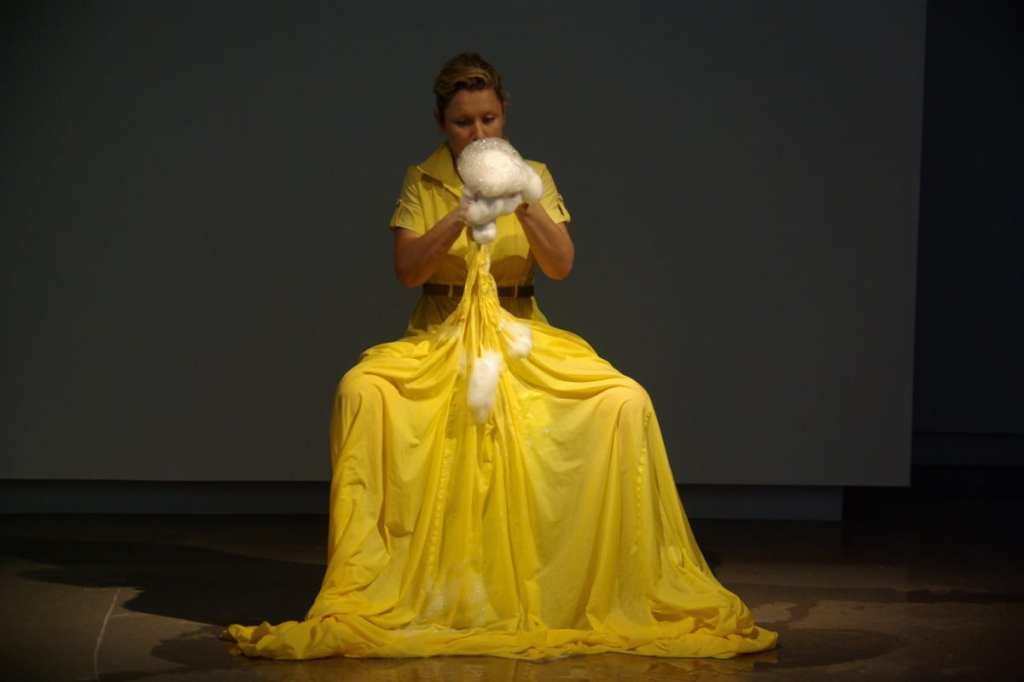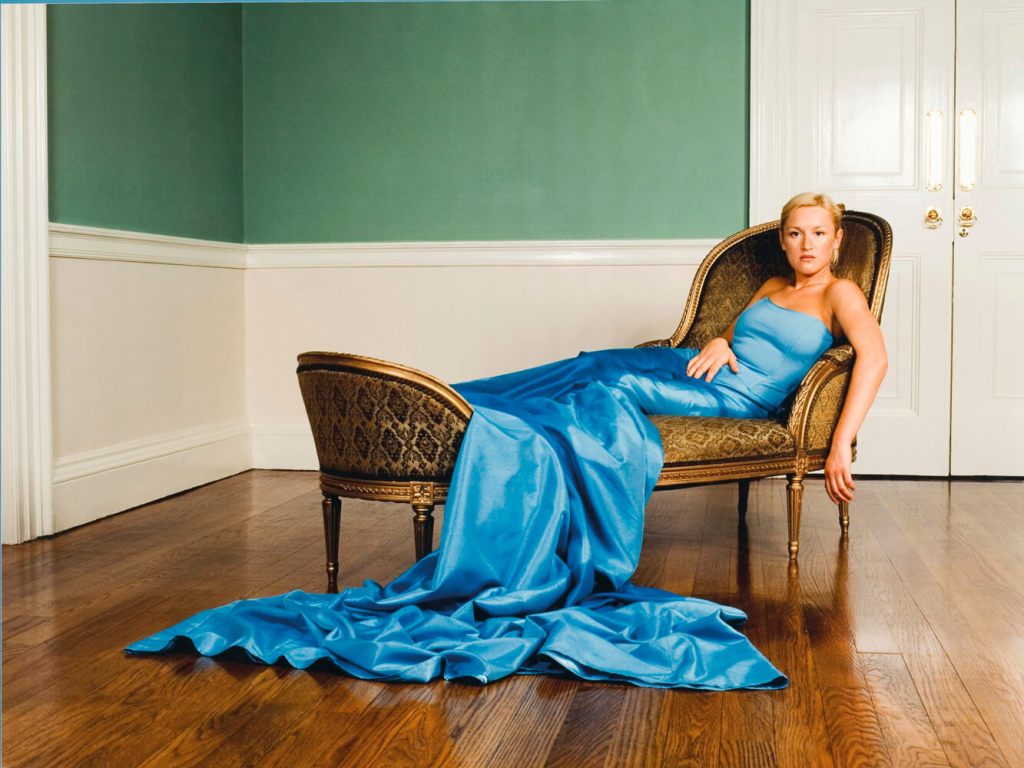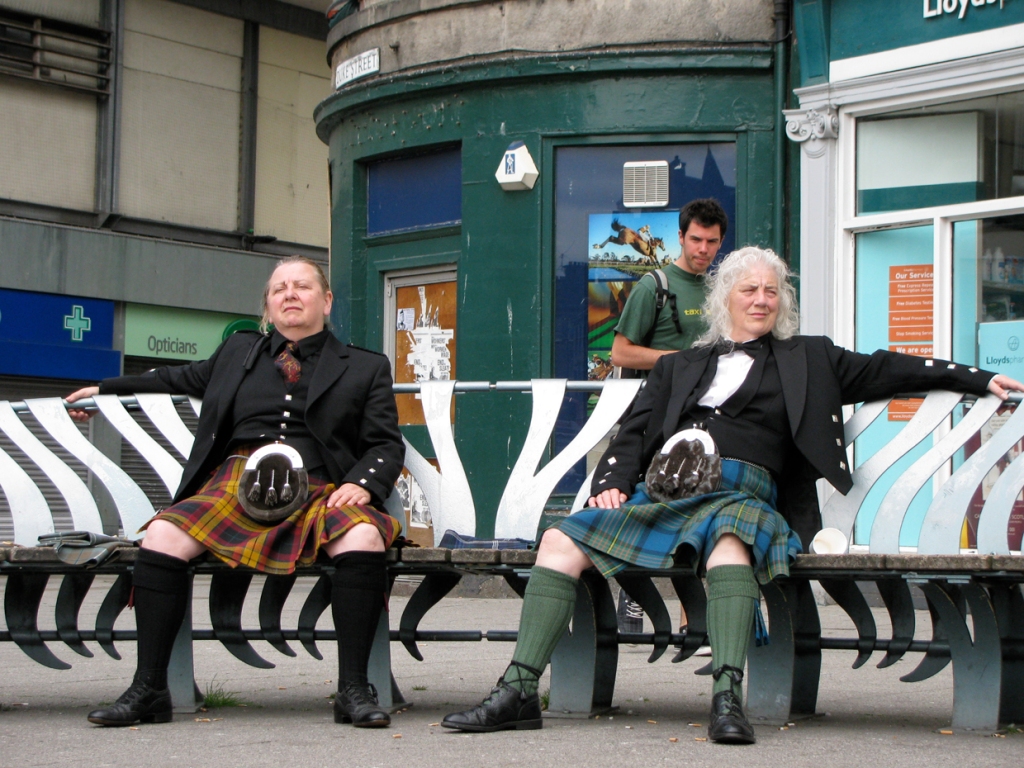Marie Kelly, graduate of the 2023 MA in Art History, Collections and Curating, examines the complex roles and meanings of dress at the intersection between feminism and performance art.
I have worked as a fashion journalist for many years, and during this time, I have reported on trends, interviewed designers and compared collections. But I’ve always been far more interested in clothes themselves – the individual garments we each choose to dress ourselves in every day and the power these garments have to speak on our behalf. When I began my MA in History of Art, Curating and Collections at UCD in September of 2022, I knew only that dress would be a feature of my research. I knew nothing of performance art at this time and had imagined myself examining evocative Impressionist works or iconic Renaissance paintings, but when I met with Dr Róisín Kennedy to explore possible thesis topics, she suggested I take a look at Amanda Coogan’s oeuvre – in particular her durational performance piece Yellow. It struck a chord that initiated a fascinating investigation into how performance artists have, for decades, used dress to destabilise and deconstruct traditional female stereotypes.

- Amanda Coogan, Yellow at IMMA (2008).
Much has been written about how the body is used as a medium in performance art, but my early investigations revealed that very little research had been undertaken into the function of dress, despite the fact it featured heavily in the works of iconic 20th-century performance artists, from Yoko Ono to Marina Abramović. Choosing a topic that was under researched was inviting for obvious reasons, but an enormous part of the appeal of this topic was the opportunity it afforded to demonstrate that from the margins, the centre can be disrupted. Very early on in my research I discovered that textiles have long sat outside the artworld’s traditional hierarchy of materials. Performance art, too, originated on the margins and has, along with textiles, only relatively recently been accepted into the mainstream. Women artists themselves were ignored and under-represented for centuries. I was intrigued that despite these sizable roadblocks, women performance artists used dress – a maligned material – in performance art – a peripheral genre – to interrogate, undermine and deconstruct fundamental concepts essential to the structures of patriarchy.

- Amanda Coogan, Medea (2001).
I anchored my thesis around two case studies. The first focused on Amanda Coogan’s 2008 work Yellow and her earlier performance piece Medea (2001), both of which were performed in traditional gallery settings. The second centred on Frances Cummins’ and Pauline Mezzetti’s series of performance works titled Walking in the Way: Performing Masculinity, performed in the public arena of nine different European cities between 2009 and 2013. While Coogan wore traditional female attire for both her performance pieces, i.e. full-length dresses, Cummins and Mezzetti donned the clothing of conventional masculinity. Both case studies served as contrasting but complementary examples of how female performance artists employed all kinds of dress to free themselves from the attributes, qualities and sensibilities that have been defined and imposed by men – the dominant subjects in art and life – throughout the ages.

- Frances Cummins and Pauline Mezzetti, Walking in the Way: Performing Masculinity, various locations 2009–13.
To provide context for both case studies and to position performance art within 20th-century artistic practice and feminist discourse, I wrote an introductory chapter explaining the association between feminism and performance art, which developed almost immediately, as female artists in the first half of the 20th century reevaluated the relationship between art, life and politics and looked for artistic approaches outside of the existing white, male, western art canon and traditional gallery system. This chapter included early influences on, and examples of, the genre, and the role dress played within them. It led me to explore important works by Surrealist artists Leonora Carrington and Claude Cahun and 1970s American performance artists Adrian Piper and Eleanor Antin. Although my thesis focused on contemporary art, it required a thorough understanding of the early-modern period and featured an analysis of significant works by Impressionists Mary Cassatt and Edouard Manet also.
My research focused on three key themes. The first was the material presence of dress in performance art. By this I mean the histories and associations inherent within dress, its emotive tactility and its dynamic collaborative function within a work. Textiles have long been associated with femininity and women’s history and this has imbued them with an emotional charge made more powerful by the fact that they are containers for memory – textiles and clothes harness traces of their maker and of every individual who wears them. By virtue of this, dress becomes its own ‘character’ within each performance piece, with meaning emerging not simply from its intrinsic qualities but from its use, representation and relationship with other entities. The second approach involved examining the relationship between gender and sex and the manner in which performance artists used dress to explore the former as a social construct rather than an expression of the latter. In each case study, gender was exposed as an unstable identity, a corporeal ‘style’ adopted and socially policed in order to sustain binary categories of man and woman, not a natural given. It became clear that gender and dress are, in fact, often oppositional. Thirdly, I explored clothes as historically delineated signifiers of both maleness and womanhood and identified how performance artists played on the arbitrariness of this to fracture the patriarchal structures that bind female and femininity together.
My research yielded an exciting debunking of several key patriarchal myths. By harnessing the power of dress – its particularly female histories, associations and materialities – within the powerful medium of performance art, Coogan, Cummins and Mezzetti punctured the fantasy of woman as aesthetic object of contemplation, collapsed the superstition around a woman’s sexuality as transgressive and dangerous, reframed gender as a daily practice of dress rather than a matter of biology, undermined the masculine codings that inform the category of artist as male Genius and exploded the myths around a woman’s ‘place’ within the private and public sphere.
While I would never have anticipated choosing performance art for my thesis topic, it allowed me to immerse myself fully in my three main areas of interest: art, fashion and feminism. I found the experience completely absorbing and hugely satisfying. It’s thanks to the superb direction I received from Dr Roisin Kennedy that this part of my MA programme proved to be so enjoyable and rewarding.